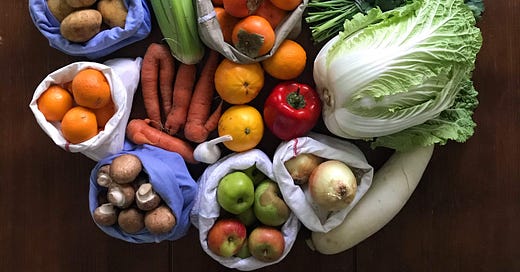I gave a talk a few days ago about running a more sustainable kitchen. I began with the short version of my talk. It goes as follows: Eat lots of vegetables. (While that advice sounds simple enough, not everyone can adhere to it in our current unjust, industrial food system.)
But if you can… when you eat more vegetables, your kitchen routine becomes simpler and, literally, greener.
Eating more plants is one of the top climate solutions
Project Drawdown outlines the top 100 solutions for reducing emissions or sequestering carbon from the atmosphere, with each solution ranked based on the amount of greenhouse gas it can reduce or remove before 2050. These solutions will also create jobs, improve health, reduce hunger, save money, regenerate the soil, restore rivers, clean the air and more.
Drawdown analyzes and ranks the solutions according to two scenarios. In Scenario 1, the planet’s temperature increases 2˚C by 2100. In Scenario 2, it increases 1.5˚C. Under Scenario 1, eating a plant-rich diet ranks third out of 100 solutions. It ranks fourth under Scenario 2. (Reduced food waste ranks first and third respectively.) Under either scenario, a plant-rich diet will do more than electric cars, LED lighting and concentrated solar power—combined.
The meat-centric Western—increasingly global—diet accounts for about 20 percent of global emissions according to the Drawdown website. Other sources put that number as high as 60 percent. Whatever the figure, I doubt it comes as a surprise that growing and harvesting a pound of lentils impacts the environment less than producing the equivalent amount of beef. And many of us need to eat way more of those lentils according to the Planetary Health Diet.
The science-based Planetary Health Diet “tackles both the poor food eaten by billions of people and averts global environmental catastrophe.” It calls for a 50 percent decrease in red meat and sugar and a two-fold increase in fresh fruit and vegetables, legumes (beans, lentils, peas) and nuts globally. To eat the recommended amounts of these foods, the average North American must “eat 84% less red meat but six times more beans and lentils. For Europeans, eating 77% less red meat and 15 times more nuts and seeds meets the guidelines.”
Eating less meat and more beans and lentils can also save money. I can buy a pound of organic chickpeas for less than $3. That cooks up to over seven cups, which will make a giant vat of hummus that we can eat all week. A similar amount of protein higher up the food chain costs much, much more. And if you take health care costs into consideration, those chickpeas can rack up the savings long-term. Drawdown estimates that healthier plant-rich diets can save $1 trillion worldwide in healthcare costs and productivity losses.
To put more legumes on your plate, check out my recipes for dal, pumpkin dal, chana masala, not-too-spicy black beans and hummus.
But how does it taste?
Worried your plant-rich dishes will taste bland? Cook with herbs and spices—cumin, turmeric, crushed chilies, cayenne powder, mustard seed, cardamom, coriander, rosemary, oregano, thyme, cinnamon, cloves, fresh garlic and ginger and so on (maybe not all at once…).
Garnish dishes with fermented foods, such as kimchi, preserved lemons, hot peppers or homemade yogurt. Fermented foods provide incredible flavors and umami, they can benefit your gut health and they are easy to make (or buy them in the refrigerator section of the grocery store). You’ll find lots of fermented foods in my recipe index and more in my cookbook.
And note that “plant-rich” means you’ll eat lots of plants, not only plants (i.e., you don’t have to go vegan).
Today’s action: Eat lots of fresh fruit and vegetables
If you don’t know where to start, cover half of your plate with vegetables at dinner tonight. Bon appétit!
Please leave a comment or question below and let us all know how the challenge is going. What is your favorite plant-rich dish?





Totally agree! I've been weaning my meat loving husband off meat slowly by reducing meat in recipes by half and filling the void with plants, e.g. 1/2 lb. ground beef and lentils for bolognese sauce or quinoa for meatloaf or mushrooms for burgers. He hasn't even noticed!
This is so timely! My husband and I just gave up both meat and plastics on January 1. We are making many more meals from scratch, but because we prep and cook 'in bulk' we're actually saving money and time - and grooving to some cool tunes while we do it! One vat of beans can be split to make chili (add onions, peppers, tomatoes and spices) and Minestrone (add tomatoes, garlic, basil, carrots, onion, celery kale, Italian herbs). We store these in mason jars in the fridge and they can be a 'fast food' lunch in themselves or a full meal with the addition of a salad and a thick slice of home-made bread. Yum!